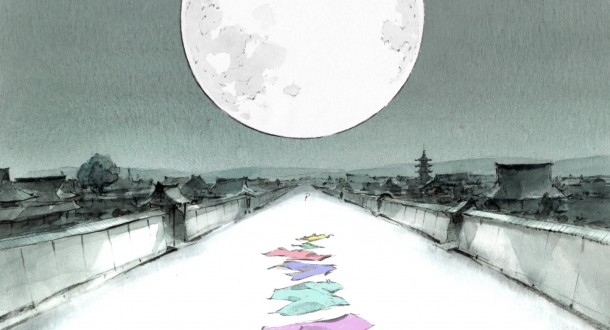
Dir.: Isao Takahata
Animation with the voices of Aki Asakura, Takeo Chii, Nobuko Myamato
Japan 2013, 137 min.
Based on the oldest recorded Japanese narrative ‘Taketori Monogatari’, THE TALE OF PRINCESS KAGUYA is the swansong of Isao Takahata (GRAVE OF THE FIREFLIES), co-founder of Studio Ghibli with Hayao Miyazaki. There are several screen adaptations of the story, the best known being Kon Ichikawa’s 1987 life version “THE PRINCESS FROM THE MOON”.
A bamboo cutter Okinia (Chii) finds a doll like girl sprouting from a bamboo shoot. He takes her home, but she is already growing in his hands. A few weeks later she is a young, wild teenager, running through the woods with the boys. Okina and his wife Ona (Myamato) call their foster daughter “Little Princess”, whilst the boys have named her “Little Bamboo”, because of her quick growth. The princess (Asakura) shows no signs of being different from her playmates, but when her foster father finds a cache of gold and fine, colourful garments in the wood, he realises that his foster daughter is destined to grow up a princess at court. The family moves, to the chagrin of Little Bamboo, who hates the court and her new teacher, who tries to turn her into a lady. She is even given a new name, Kaguya, meaning “creature of light”. Soon five famous suitors appear on the scene, all wanting to marry the enigmatic stranger. But Kaguya, who longs for a simple life in the woods with her friends, sets them all impossible targets, which they fail to achieve in different ways; a clever ruse to avoid marrying any of them. Finally, the emperor’s son makes a clumsy attempt to gain her love, and she prays to the forces which placed her in the bamboo sprout, to take her back to the moon. But as soon as she has asked to be taken back, she regrets it. Meeting her girlhood friend Satumaro again, they joyfully fly through the air, Satemaro promising to keep Kaguya safe. But the date of her return is fast approaching; Kaguya knows that back home she will loose all memory of her earthly stay.
THE TALE OF PRINCESS KAGUYA is an emotional and visual tour-de-force, the main protagonist’s desires of a peaceful life in the countryside are thwarted by her materialistic parents who want to achive status in society. Kaguya tries her best to counter the desires of her parents, she even hallucinates the landscape of her childhood, whilst looking out of the window of her palace, trying to go back in time. The eastern brush painting helps to make the images dreamlike, everything is fluid and magical, the vibrant images wafting like flowers in the wind. The silk clothes of the princess give the images an even greater transcendency, culminating in the flight sequence with Satemaro. Kaguya is the epitome of grace, perfectly suiting her: she is a delicately fluttering creature, always on the move, her mood changes translated into colourful images. Some of the early scenes are redolent of an earlier Takahata animation film HEIDI, A GIRL OF THE ALPS. The ending is an array of lighting, where arrows turn into flowers, and the God of the Moon tries to persuade Kaguya to return to her anti-septic home, bereft of any emotional content. THE TALE OF PRNCESS KAGUYA is a wonderful synthesis of dreamlike images, a metaphor for the spiritual life in conflict with materialism and status. An expressionistic phantasy, rather like the paintings of Monet, Manet or Sisley coming to life. AS
ON GENERAL RELEASE FROM 23 MARCH 2015